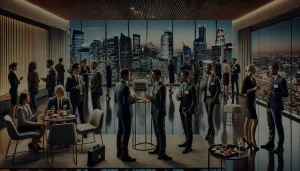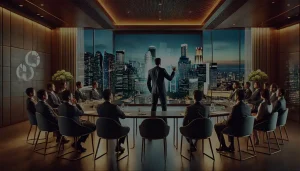Table of Contents
With each new opportunity for a professional meeting, the possibility of transforming a simple conversation into a strategic connection that can define the direction of a career and business arises. At corporate events held in luxury hotels, the sophisticated environment combines with an atmosphere of exclusivity, creating the ideal setting for developing meaningful and high-value relationships. In this article, we will explore in detail the best practices and strategies for making the most of these opportunities, ensuring that each interaction becomes a step towards professional and personal success.
The Current Corporate Events Landscape
Corporate events have evolved significantly in recent decades. Previously, business meetings were based solely on lectures and networking sessions, but today they feature a variety of activities that promote more natural and in-depth interaction between participants. This new format encourages the exchange of experiences and the sharing of knowledge, creating a robust and dynamic network of contacts.
Transformations in the Event Environment
With the rise of technology and the globalization of markets, corporate events have begun to integrate digital tools that facilitate pre-, during- and post-event communication. Networking platforms, scheduling apps and contact management systems are just some of the features that have modernized these meetings, making them more interactive and personalized. In luxury hotels, this modernity meets the refinement of the environments, providing a differentiated experience that attracts high-level professionals.
The Influence of Luxury Hotels
You luxury hotels offer an environment that goes beyond mere comfort; they create an exclusive atmosphere where every detail is thought out to reflect sophistication and good taste. The decoration, the quality of the services and the privileged location are factors that contribute to the construction of a positive image and strengthen the confidence of the participants. This environment favors not only the interaction between the guests, but also the perception that each meeting is an opportunity to establish long-lasting and high-impact relationships.
Participant Profile
At events held in luxury hotels, the profile of participants is usually quite diverse, ranging from high-level executives to innovative entrepreneurs. These professionals share the search for connections that can add value to their careers, whether personal or business. It is common to find individuals who value the quality of relationships, preferring genuine and lasting connections to superficial interactions. This mindset creates an environment conducive to the emergence of strategic partnerships and fruitful collaborations.
Advance Preparation: The Foundation of Effective Networking
Success at corporate events depends not only on what happens during the meeting, but also on the preparations made in advance. Investing time in organizing and planning the actions to be developed is essential to ensure that each opportunity is taken to the fullest.
Selecting the Right Events
The first step is to identify events that really have the potential to add value to your network. Evaluate the reputation of the organizers, the profile of the participants and the topics covered in the lectures and workshops. Events held in luxury hotels tend to attract a selective and engaged audience, which can represent an excellent opportunity to expand your professional horizons.
Selection Criteria
- Relevance of the Topic: Make sure the topics covered at the event are aligned with your professional goals and personal interests.
- Quality of Participants: Research the speakers, guests, and companies that will be present. Events that bring together industry leaders and innovators tend to provide more valuable connections.
- Location and Infrastructure: Luxury hotels offer an experience complete, with well-planned spaces for networking, sophisticated living areas and high-quality services.
Setting Goals and Objectives
Before the event, it’s essential to set clear goals for networking. Think about how many connections you want to make, what types of professionals you’d like to meet, and what information you want to gather. Setting goals helps direct interactions and makes the process more strategic.
Planning Strategies
- Set Priorities: Identify the contacts that can make a difference in your career and focus your efforts on them.
- Create a Script: Plan times during the event when you want to engage with your target audience. This could include coffee breaks, Q&A sessions during the presentations, or relaxing moments in the common areas.
- Prepare Support Material: Update your resume, portfolio, and professional profiles on networks like LinkedIn. Business cards and short presentations are also essential to convey a professional and well-prepared image.
Digital Connections Before the In-Person Meeting
Digital preparation has proven to be an effective strategy for optimizing networking. Connecting with other participants before the event can make it easier to get closer on the day, as you will have a common reference point to start the conversation.
Pre-Connection Tips
- Act on Social Networks: Use professional platforms to connect with organizers and participants. Send personalized messages showing interest in learning more about each other’s work.
- Join Groups and Forums: Many events create online communities where attendees can interact before the event. Participating in these discussions can increase your profile’s visibility and generate positive connections in advance.
- Share Relevant Content: Posting articles, news or insights related to the event theme can attract the attention of professionals who share the same interests.
During the Meeting: Techniques and Approaches for Valuable Connections
On the day of the event, prior preparation turns into action. The ability to interact naturally and Strategic thinking is crucial to transforming opportunities into lasting relationships.
Efficient Approach and Communication
First impressions are crucial. A confident demeanor, combined with clear and empathetic communication, can open doors to meaningful conversations. Try to start dialogues authentically, avoiding rigid and standardized approaches.
Communication Practices
- Active Listening: Show genuine interest in what the other person has to say. Asking questions and confirming important points shows respect and helps to create a bond.
- Positive Body Language: Smiling, maintaining eye contact and adopting an open posture are attitudes that convey confidence and receptiveness.
- Stories and Examples: Sharing personal experiences or success stories can make the conversation more engaging and memorable.
Participation in Event Dynamics
Corporate events often offer a variety of activities, such as workshops, roundtables, and interactive sessions. Taking advantage of these opportunities is essential to expanding your network of contacts in an organic way.
Engagement Tips
- Participate Actively: Be present in all activities, not just as a spectator, but as an active participant. Raise questions, contribute ideas, and show interest in collaborating.
- Take Advantage of Breaks: During your breaks, look for opportunities to interact with your colleagues. A coffee break or a moment of relaxation can be the perfect setting to start an informal conversation.
- Get involved in Group Dynamics: Group activities allow you to meet people in a more natural way, making it easier to get closer and create more authentic bonds.
Networking Tools and Applications
Technology can be a powerful ally when it comes to making connections at events. Many corporate meetings offer their own apps that make it easier to exchange information and schedule quick meetings.
Examples of Useful Tools
- Networking Applications: Platforms like Whova and Brella help you identify and connect with other participants based on common interests and goals.
- Instant Messaging Platforms: WhatsApp or Telegram groups created for the event allow for quick communication and the organization of informal meetings.
- Scheduling Systems: Tools that allow you to schedule meetings during the event can optimize time and ensure that you don't miss the opportunity to talk to strategic professionals.
Time Management and Organization
At busy events, time management is essential to ensure you take advantage of every opportunity without getting overwhelmed.
Strategies for Effective Management
- Plan your Agenda: Review the event schedule and define which sessions are a priority for your goals. Set times for breaks and networking opportunities.
- Use Alarms and Notifications: Technology can help you stay focused and remember your commitments. Use alarms or calendar apps to make sure you don’t miss any opportunities.
- Keep a Balance: Try to balance moments of intense interaction with strategic pauses to rest and reflect on the connections made.
After the Event: Strengthening Relationships and Turning Connections into Results
The work carried out during the event takes on new importance in the post-meeting period. Consolidating the connections made is essential for them to become solid partnerships and concrete opportunities.
Effective Follow-Up
Post-event communication is a crucial step to reinforce interest and demonstrate professionalism. Sending personalized messages thanking the event attendee for the meeting and reinforcing points discussed can make all the difference.
Tips for a Successful Follow-Up
- Personalize Contact: Avoid generic messages. Mention details of the conversation or any common interests identified during the event.
- Be Punctual: Get in touch soon after the meeting, while the memories are still fresh and the excitement is shared.
- Propose New Encounters: Suggest a new meeting, whether for coffee or a video call, to deepen the conversation and explore possibilities for collaboration.
Organization and Monitoring of Contacts
Keeping an organized record of your contacts is essential to turning one-off connections into future opportunities. Using management tools can make this process easier and ensure that no valuable contacts fall through the cracks.
Tools and Techniques
- Use of Spreadsheets or CRM Software: Recording relevant information about each contact, such as interests, area of expertise and possible points of collaboration, helps maintain a clear view of opportunities.
- Definition of Reminders: Set dates to reconnect and schedule alignment meetings. This practice demonstrates commitment and continued interest.
- Contact Segmentation: Classify contacts according to relevance and collaboration potential, which will allow for more targeted and effective follow-up.
Evaluation of Results
Analyzing the results obtained through networking is an important step in identifying successes and opportunities for improvement. Evaluating the quality of connections and conversions into business opportunities allows you to adjust strategies for future events.
Success Indicators
- Number of Meaningful Connections: Quantify the contacts that really added value to your networking.
- Conversions into Opportunities: Analyze how many contacts turned into partnerships or concrete projects.
- Personal Feedback: Reflect on interactions and identify strengths and areas for development to improve future participation.
Sharing Experiences
One practice that strengthens collective learning is sharing experiences during the event. Publishing reports, insights and learning not only reinforces professional authority, but also encourages the exchange of knowledge with the network of contacts.
Suggestions for Sharing Knowledge
- Publication on Blogs or Social Networks: Write about the experience, highlighting the most relevant points and lessons learned.
- Participation in Interviews and Podcasts: Sharing your journey and strategies can inspire other professionals and expand your network of influence.
- Workshop Organization: Holding meetings to discuss the challenges and opportunities identified during the event can generate new partnerships and strengthen networking.
Case Analysis and Practical Examples
To better understand how strategies are applied in practice, it is essential to analyze real cases of professionals and companies that stood out in corporate events held in luxury hotels. These experiences serve as a source of inspiration and offer valuable insights for those who want to replicate their success.
Successful Example in Corporate Events
Imagine an executive from a multinational company who regularly attends meetings in hotels luxury. By preparing in advance, he identified a group of professionals who worked in areas that complemented his own. During the event, his proactive approach and ability to listen actively allowed him to establish deep and sincere connections. After the meeting, consistent follow-up transformed these interactions into strategic partnerships that yielded important collaborative projects.
Lessons Learned from Case Studies
- Planning and Preparation: Success is directly related to the ability to prepare meticulously, identifying opportunities and setting clear goals.
- Authenticity in Interactions: Genuine and personalized approaches generate stronger and more lasting connections.
- Post-Event Persistence: The commitment to maintaining contact and the willingness to collaborate are differentiators that transform a simple conversation into a business opportunity.
Expert Interviews
In several interviews with renowned professionals, one thing that has been consistently noted is the importance of empathy and active listening. Many experts claim that the best networking moments occur during spontaneous conversations, where the exchange of experiences and mutual collaboration emerge naturally. These practices, when combined with a luxurious environment, enhance the reach of connections and create a truly strategic network of contacts.
Resources and Tools to Enhance Connections
In addition to preparation practices and active participation, several tools can help organize and enhance connections made at corporate events. The intelligent use of these resources helps maintain the flow of communication and optimize results.
Digital Networking Platforms
- Event Specific Applications: Tools like Whova and Brella allow attendees to connect in advance, exchange information, and schedule meetings during the event.
- Professional Networks: Keeping profiles updated on platforms like LinkedIn is crucial to expanding your network and strengthening the bonds established during the meeting.
Relationship Management Software
Using contact management systems (CRM) helps you organize and track your connections. These software programs allow you to record relevant information about each contact and schedule follow-ups, ensuring that no valuable relationship is forgotten.
Communication Tools
- Email and Personalized Messages: Using well-crafted and personalized messages for follow-up demonstrates professionalism and reinforces the good impression left during the event.
- Scheduling Meetings: Scheduling apps make it easier to schedule appointments, optimizing the time and logistics of post-event meetings.
Professionals who adopt this approach tend to build relationships that stand the test of time and become true networks of support and collaboration. By applying the strategies presented, you not only maximize your chances of success, but also contribute to the creation of a more collaborative and innovative business environment.
Considerations for Developing Lasting Connections
One of the biggest lessons learned from corporate event experience is the importance of nurturing established relationships. After the meeting, it is essential to transform the initial enthusiasm into concrete actions that keep the dialogue and collaboration going.
Practices to Strengthen Relationships
- Establish Contact Routines: Set a frequency for sending messages, sharing news or scheduling informal meetings. This practice helps keep the connection alive and demonstrates your commitment to the relationship.
- Share Relevant Content: Whether it’s through articles, reports, or industry insights, providing useful information to your contacts strengthens relationships and positions you as a source of knowledge.
- Organize Periodic Meetings: If possible, organize face-to-face or virtual meetings to discuss news and opportunities. These moments of interaction strengthen the network and allow for the ongoing exchange of experiences.
The Importance of Authenticity
In an environment where luxury and sophistication are the main attributes, being authentic can be the difference that separates a simple interaction from a successful partnership. Authenticity in professional relationships translates into trust, and trust is the basis of any long-term collaboration.
Being open to sharing not only successes but also challenges creates an environment of reciprocity and empathy. This attitude can inspire other professionals to do the same, generating a positive cycle of support and collaboration.
Real Examples and Practical Inspirations
To illustrate how strategies can be applied in a practical way, let's look at some examples of professionals and organizations that stood out in corporate events held in luxury hotels.
Success Story: Turning an Event into a Business Opportunity
At a renowned business meeting held at a five-star hotel, a project manager identified, during an interactive workshop, a group of professionals who shared similar challenges to those in his area of expertise. Taking advantage of a coffee break, he started a relaxed conversation that quickly evolved into an exchange of experiences and insights. After the event, systematic follow-up resulted in the formation of a consortium focused on innovation in internal processes, which later culminated in a joint project that generated recognition in the sector.
Inspiration from Real Stories
Another inspiring story is that of an entrepreneur who attended an international networking event held at a luxury hotel. Before the event, she conducted detailed research on the attendees and identified potential strategic partners. During the event, her authentic approach and willingness to actively listen enabled her to build a diverse and highly relevant network of contacts. After the event, sharing her experience on a specialized blog attracted the attention of investors, resulting in raising funds to expand her business.
These cases demonstrate that, regardless of the size or area of activity, the key to success lies in preparation, authenticity and continuity of the relationship. These are simple actions, but with a significant impact, that can transform an event into a true turning point in a professional career.
Stimulating Innovation Through Networking
The intersection between the sophistication of luxury hotels and the dynamics of corporate events creates an environment conducive to innovation. The diversity of professionals present and the quality of interactions open up space for the exchange of ideas and the emergence of innovative projects.
Collaborative Initiatives
Professionals who engage in collaborative initiatives tend to have a broader and more integrated view of market challenges. Informal meetings and discussion groups formed during the event can become innovation labs, where different perspectives come together to solve complex problems and develop creative solutions.
The Influence of Luxury Environments on Creativity
You luxury hotels, with its attention to detail and global experience, inspires a mindset focused on excellence. This environment can encourage participants to think outside the box, creating a space where creativity and innovation naturally flourish. The harmony between the high-quality infrastructure and the energy of the participants results in synergies that drive the emergence of new ideas and opportunities. business.
Stimulating Action and Reflection
Each strategy, tip, and example presented here serves as a call to action. The corporate events scene at luxury hotels offers unique opportunities for those willing to invest time, dedication, and creativity in building a solid and influential network of contacts. The lessons learned demonstrate that true networking success lies not in accumulating business cards, but in transforming each encounter into a concrete opportunity for growth.
Reflecting on the practices discussed here can drive a significant change in the way professionals interact and collaborate. By adopting these strategies, you put yourself in a privileged position to take advantage of the best opportunities in the market, creating a virtuous cycle of connections that translates into success and recognition.
Every interaction in a sophisticated environment is a chance to redefine your own trajectory. Whether you are a experienced executive or a professional just starting out, the strategies presented are applicable to different contexts and can be adapted to meet your specific needs. The key is to recognize that, in corporate events held in luxury hotels, excellent communication, prior preparation and persistence after the meeting are essential elements to transform contacts into long-term collaborations.
The expertise acquired through practice and observation of the best examples in the market reinforces the idea that success in networking is directly related to commitment to each stage of the process. Preparing in detail, acting authentically and maintaining a proactive stance are attitudes that, when combined, raise the standard of professional relationships and create an environment of continuous opportunities.
As you put these strategies into practice, remember that each event is a new opportunity to learn, grow, and expand your horizons. Networking is an ongoing investment, where sharing experiences and collaborating with others can transform challenges into meaningful achievements.

Cosmopolitan executive, business travel consultant and luxury hotel lover, Alexander Belmont shares exclusive insights into premium experiences in metropolises around the world.




